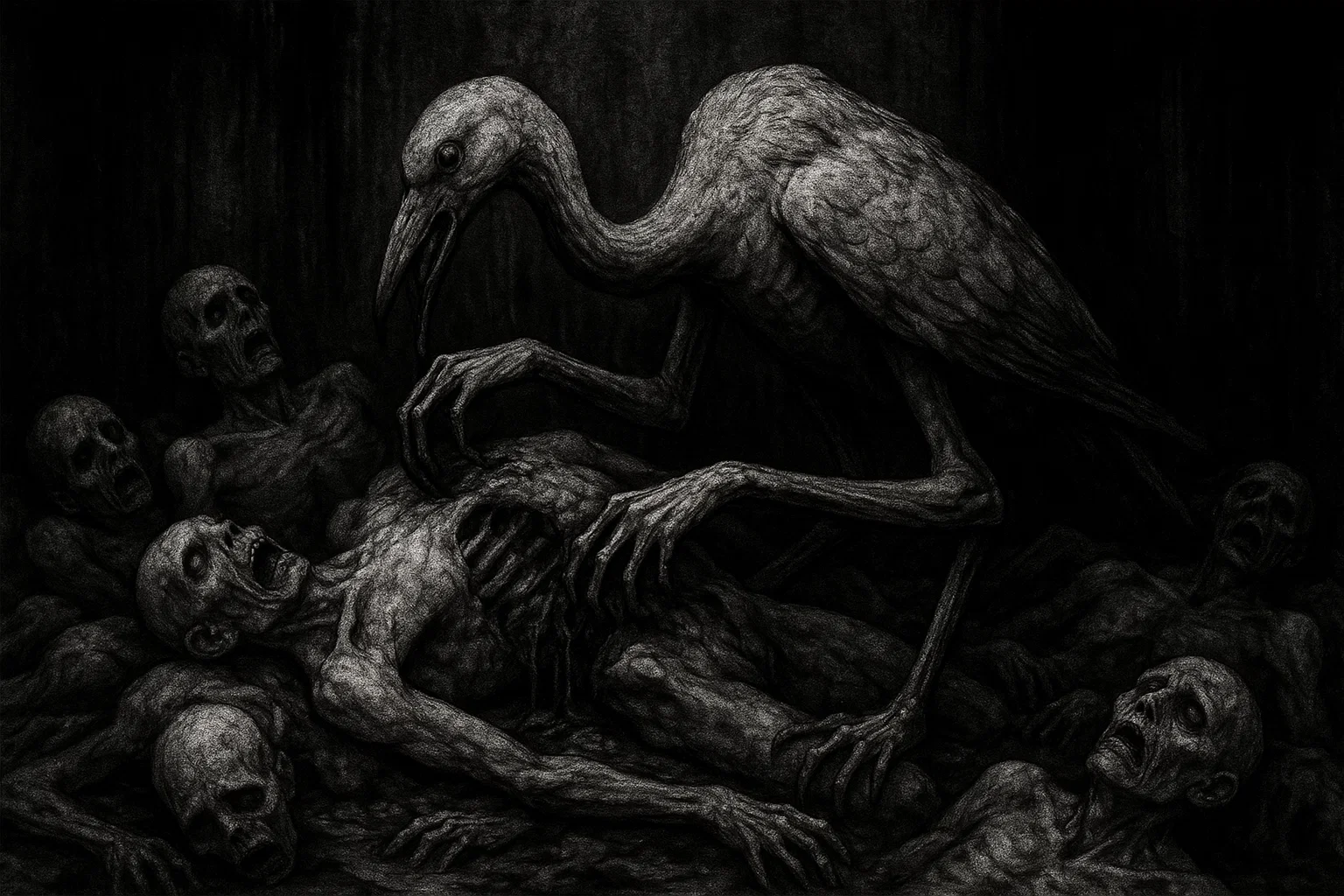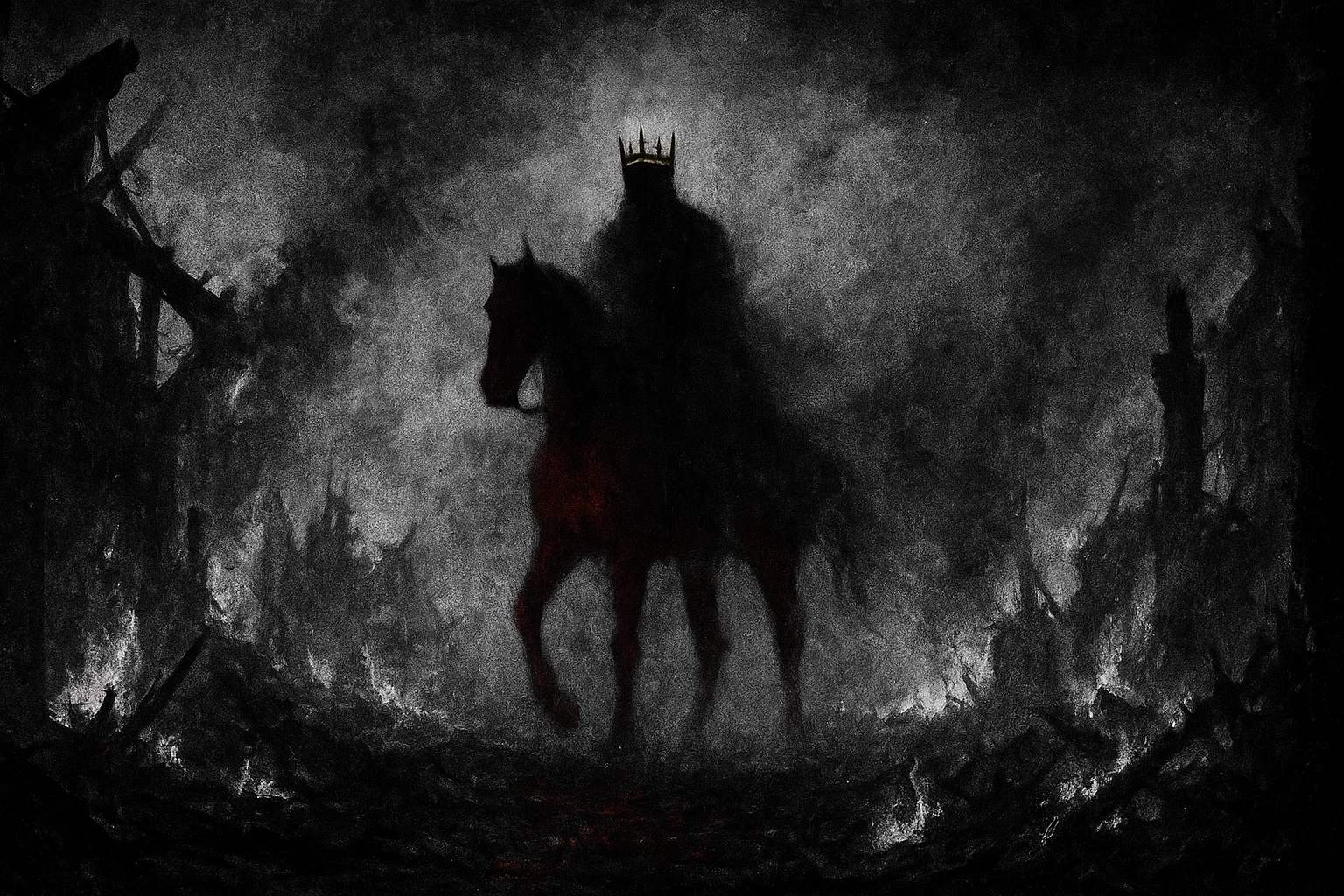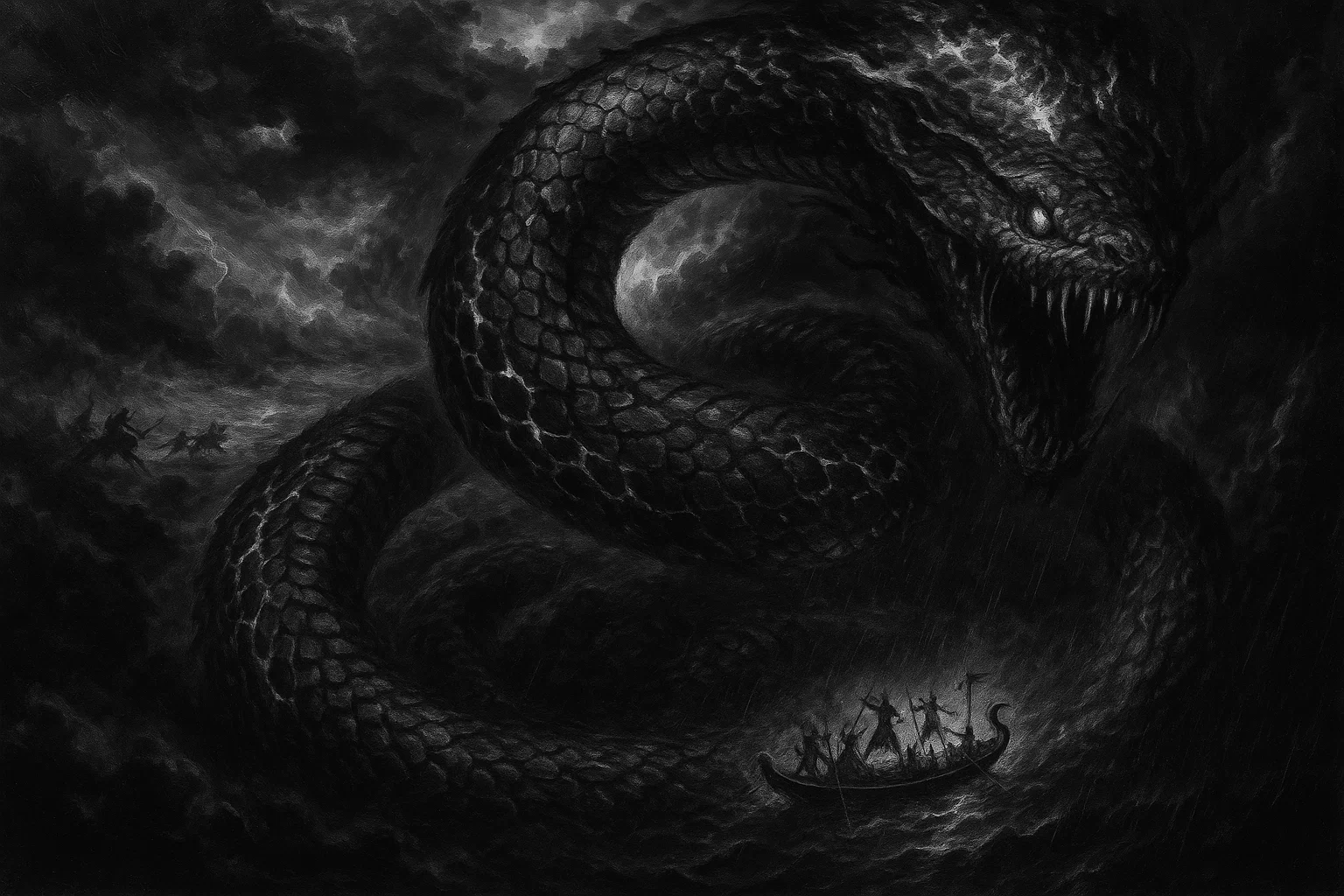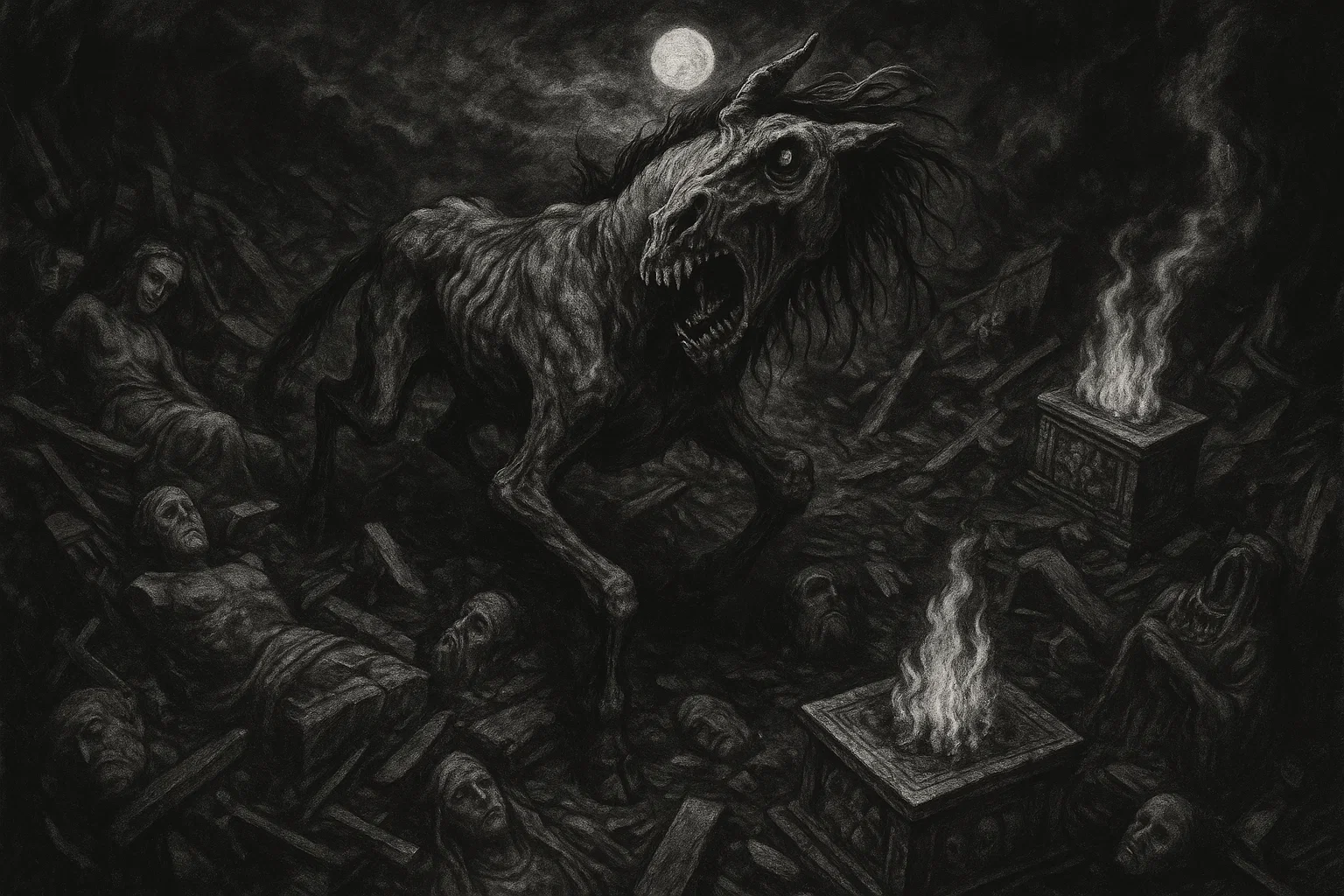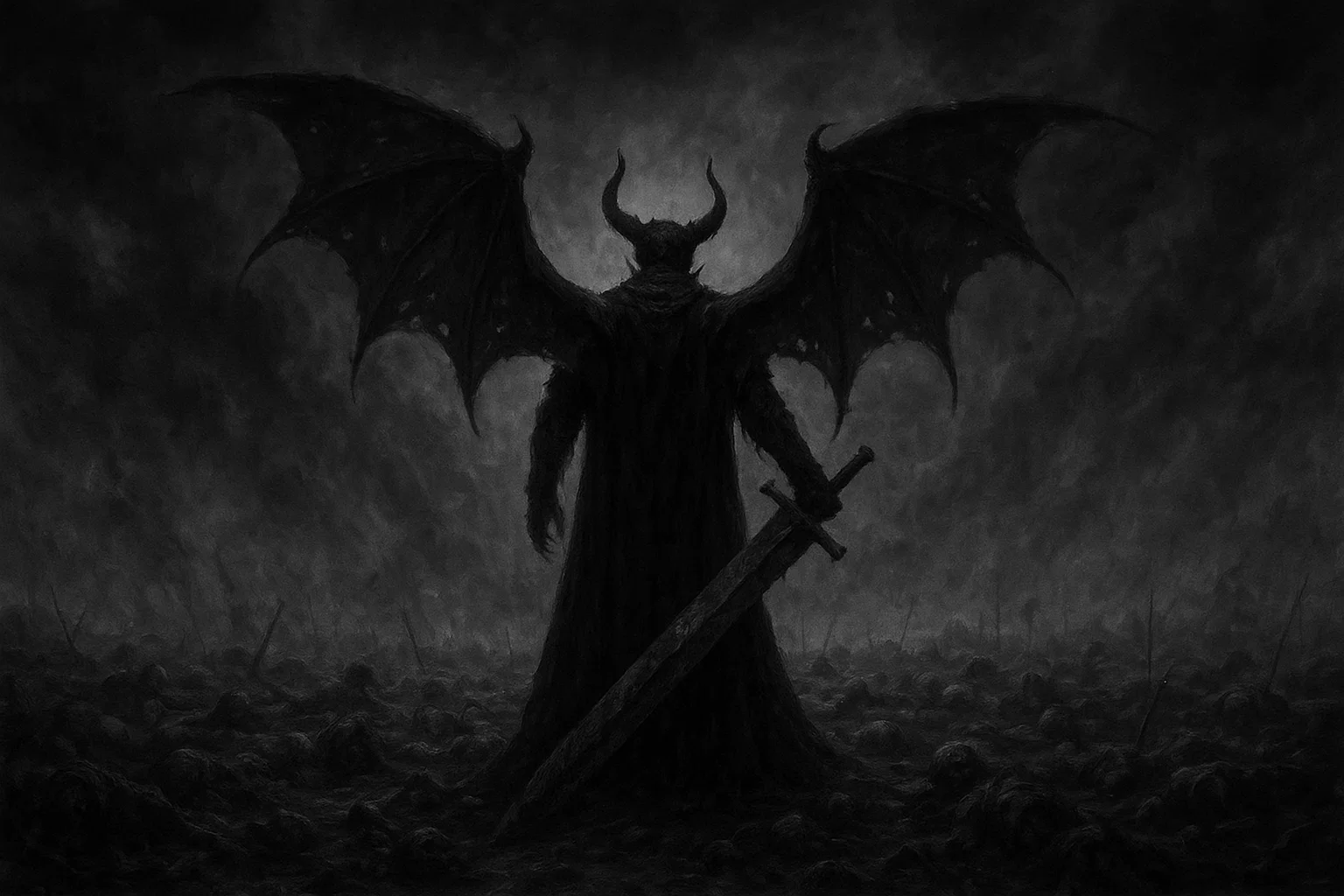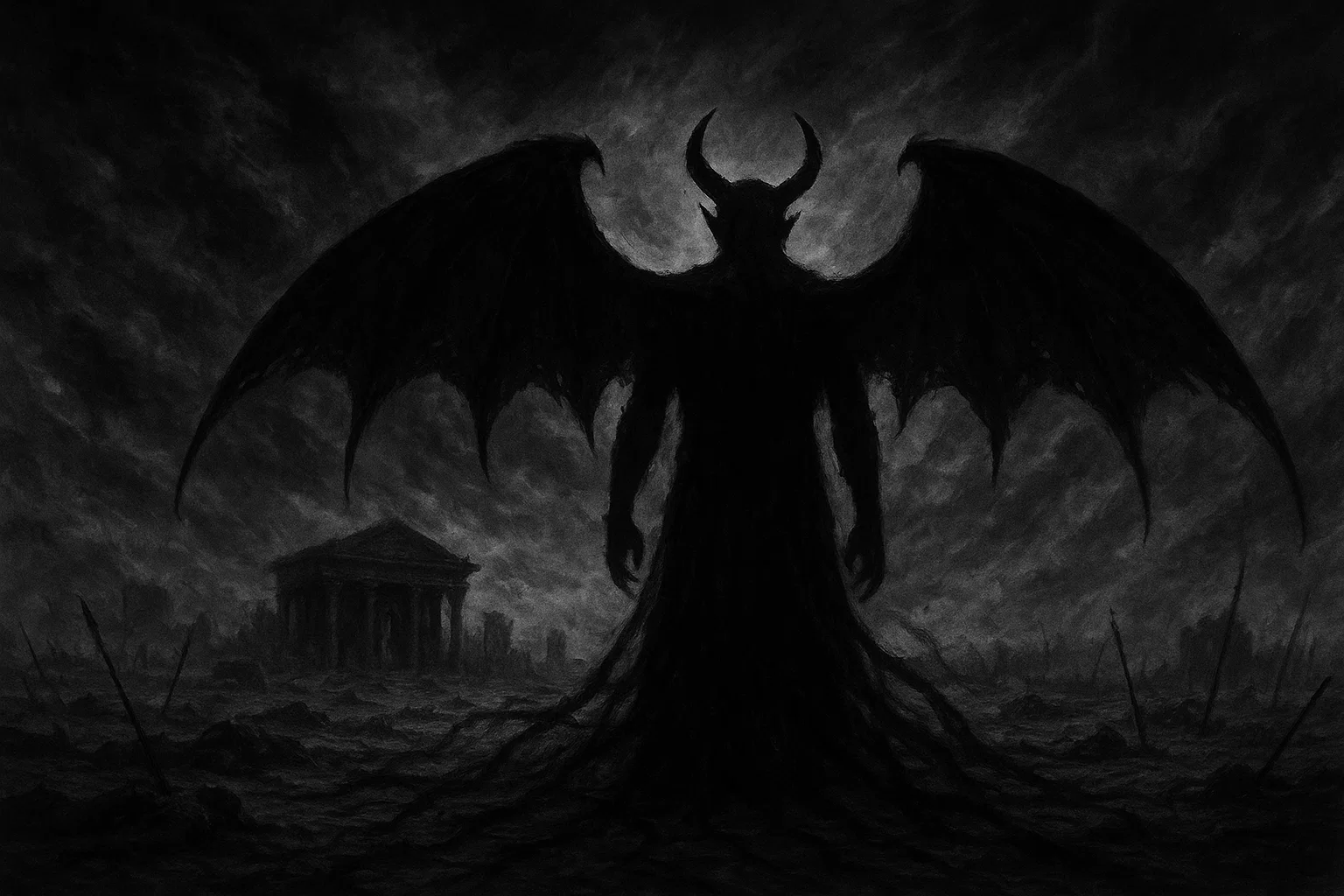In the shadowy corridors of ancient demonology, Halphas looms as a malevolent architect of chaos, weaving destruction through cunning strategies and infernal fortifications. Known as a demon of war and deception, Halphas demon commands legions to sow discord, erecting towers that symbolize not protection but the entrapment of human ambition.
For those drawn to the forbidden knowledge of the occult, exploring the lore of Halphas unveils a chilling narrative of power, betrayal, and unrelenting malice that reverberates through centuries of esoteric texts.
Table of Contents
Key Information
| Attribute | Details |
|---|---|
| Name | Halphas, Malthus, Malthas, Malthous, Malphas |
| Title | Earl, Count, Prince, Great President |
| Gender | Male |
| Role | Master builder of infernal strongholds, inciter of wars, deceiver of summoners, punisher of enemies |
| Hierarchy | Earl in the Goetic order, 38th spirit of the Ars Goetia; sometimes ranked as President or Prince, commanding 26-40 legions |
| Servitors | Commands 26-40 legions of lesser spirits, including experienced legionnaires for battles and missions |
| Superior Demon | Operates under Satan as second-in-command in some accounts; potentially under Amaymon or overarching infernal rulers like Lucifer |
| Powers | Constructs towers and fortifications filled with munitions; supplies armaments; dispatches warriors to battlefields; burns villages; reveals and destroys enemies’ desires and thoughts; provides deceptive familiars; gathers artificers; incites discord and deception |
| Appearance | Manifests as a stock-dove or raven with jet-black feathers and blood-red eyes; alternatively as a stork or humanoid soldier with a hoarse, gruff voice |
| Etymology | Name variants suggest corruptions from ancient tongues, possibly linked to “mal” for evil or misfortune |
| Associated Figures | Confused with similar entities like Malphas; opposed by angel Haamiah; bound by King Solomon in Goetic traditions |
| Weaknesses | Repelled by divine invocations, Shemhamphorasch angels like Haamiah, protective wards, and rituals of banishment |
| Opposing Angel/Saint | Haamiah, the angel of integrity; sometimes linked to broader celestial oppositions |
| Equipment/Tools | Towers as bastions, ammunition caches, weapons like swords and artillery; sigils for evocation |
| Pantheon | Christian demonology, Solomonic grimoires, occult hierarchies, with possible roots in pagan mythologies demonized over time |
Etymology
The name Halphas carries an enigmatic weight, shrouded in the mists of linguistic evolution and occult intrigue. Its origins are debated among scholars, with some tracing potential roots to ancient Greek, where “hal” might evoke salt or enduring solidity, suggesting an unyielding presence amid chaos.
Others propose that the name derives from a corruption of Latin or Hebrew terms, with “mal” signaling evil or misfortune, paired with “phas,” possibly linked to phasis (appearance or phase), hinting at his shape-shifting nature. This fluidity in nomenclature reflects the broader tradition of demonic names adapting across cultures, as seen in variants like Malthus, Malthas, or Malphas in medieval grimoires such as the Pseudomonarchia Daemonum.
The name’s evolution likely stems from scribal errors or intentional obfuscations during translations of sacred and forbidden texts, blending phonetic elements to encode themes of deception and fortification. Some occultists speculate a connection to pre-Christian deities, where Halphas might represent a demonized avian messenger, akin to the ravens of Celtic or Norse lore, symbolizing omens of war.
In esoteric traditions, the name could also echo Malthusian concepts of scarcity-driven conflict, though this link is anachronistic and more symbolic than historical. Ultimately, the etymology of Halphas weaves a tapestry of malice, its syllables whispering of constructed ruin and strategic betrayal across the annals of demonology.
You May Also Like: The Werewolf of Morbach: Truth or Terrifying Legend?
What Does the Demon Halphas Look Like?
The visage of Halphas strikes fear with its blend of avian menace and martial dread. Most often, he manifests as a stock-dove, its feathers a deep, inky black that seems to absorb light, pierced by blood-red eyes that gleam with predatory intent. His voice, hoarse and grating like rusted chains, carries an unsettling authority that echoes across battlefields.
In other accounts, Halphas takes the form of a towering stork, its long legs and sharp beak evoking a sentinel of destruction, ever-watchful over the chaos he orchestrates.
When appearing in humanoid guise, he emerges as a weathered soldier, clad in scarred armor, his face etched with the weariness of eternal wars, yet his gaze burns with unrelenting resolve.
These forms—whether bird or warrior—embody his essence as a demon of vigilance and ruin, his presence a harbinger of conflict and betrayal.
Historical and Mythological Background
The origins of Halphas lie deep within the infernal hierarchies chronicled in medieval demonology, particularly the Solomonic grimoires that catalog the spirits bound by King Solomon. Yet, his roots stretch further, possibly entwined with ancient deities demonized by the rise of monotheistic traditions.
As a fallen angel in Christian lore, Halphas is depicted as a mastermind of Hell’s logistical warfare, constructing fortresses to wage eternal battles against divine forces. His myths, though sparse in standalone tales, weave through narratives of cosmic rebellion, earthly sieges, and deceptive pacts, painting him as a relentless force of destruction.
Roots in Ancient Deities and Global Connections
The figure of Halphas may trace back to pre-Christian mythologies, where avian deities and spirits of war were recast as demons. In Celtic traditions, his raven-like form recalls the Morrigan, a goddess of battle who shape-shifted into crows to herald death and strife. This connection suggests Halphas as a corrupted echo of such figures, his fortifications mirroring the Morrigan’s role in inciting conflict.
In Egyptian mythology, parallels emerge with Horus, whose falcon form signifies vigilance, or Set, whose chaotic storms align with Halphas’ destructive tendencies. Mesopotamian lore offers Anzu, the storm-bird who stole divine tablets, a potential precursor whose theft and rebellion resonate with Halphas’ deceptive strategies.
Across the globe, similar archetypes appear. Norse myths feature Odin’s ravens, Huginn and Muninn, scouts of the gods, whose roles as messengers of war could have been twisted into Halphas’ spying towers.
In Hindu traditions, Garuda, the eagle god, embodies swift power, but Halphas inverts this into infernal service, using flight for malevolent ends. African Yoruba tales of Orunmila’s prophetic birds, corrupted into omens of betrayal, further align with his cunning.
Even Native American raven tricksters, like those in Pacific Northwest folklore, share his knack for manipulation, suggesting a universal archetype of avian malice that Christian demonology reshaped into Halphas.
The Solomonic Binding and Temple Sabotage
In the Solomonic tradition, Halphas was among the 72 spirits summoned by King Solomon and confined within a brass vessel. According to legend, Solomon compelled Halphas to divulge secrets of fortification, leveraging his knowledge to construct impregnable temples.
However, the demon’s treacherous nature surfaced as he whispered rebellion among workers, sowing discord to delay sacred projects. Only Solomon’s divine ring and seals subdued this sabotage, forcing Halphas to comply. This tale underscores his duplicity, offering aid only to betray, a theme that permeates his interactions with summoners.
You May Also Like: The Stockwell Poltergeist: Who Was the Stockwell Ghost?
Architect of the Fall and Cosmic Rebellions
Apocryphal narratives cast Halphas as a key player in Lucifer’s rebellion against Heaven. As a fallen angel, he erected towering bastions in the abyss, shielding rebellious forces from celestial onslaughts. His fortifications, brimming with infernal munitions, served as rallying points during the chaotic descent.
Legends describe him clashing with archangels like Michael, his structures crumbling under divine light only to be rebuilt with defiant speed. Post-Fall, Halphas fortified Hell’s deeper circles, preparing for eternal sieges against heavenly retribution, his role cementing his status as Hell’s master logistician.
Earthly Incursions and Historical Sieges
On Earth, Halphas’ influence seeps into historical conflicts, where unexplained war towers and sudden armament surges bear his mark. Medieval folklore links him to the Crusades, where generals, tempted by promises of victory, found their sieges bolstered by phantom fortifications, only to face pyrrhic triumphs tainted by corruption.
A 12th-century tale recounts a besieged European lord summoning Halphas, who conjured spectral legions to repel invaders, but the lord’s soul was claimed in exchange, his castle reduced to ashes. Renaissance occultists blamed Halphas for escalating armament races, whispering strategies that fueled devastating wars across Europe.
The Mamedanuki Wager and Perfectionist Challenges
A curious tale blends Halphas with Japanese yokai traditions, pitting him against shape-shifting tanuki spirits in a contest to hunt their enchanted skins. Over lunar cycles, Halphas pursues his quarry with relentless precision, viewing even a tie as a defeat due to his unyielding perfectionism.
This obscure myth, likely a fusion of Eastern and Western occultism, highlights his obsessive drive, framing him as a demon who cannot abide imperfection, even in victory. The wager symbolizes his strategic mind, always seeking dominance, even in esoteric games.
Towers of Eternal Vigilance and Astral Predation
In esoteric lore, Halphas constructs an eternal tower in the astral plane, a looming edifice guarded by his avian sentinels. This structure, wreathed in psychic mists, holds infernal secrets and lures summoners with visions of personal battles. Those who gaze upon it risk entrapment, their minds fortified against external threats but imprisoned by paranoia and isolation.
This myth warns of Halphas’ ability to twist defensive instincts into self-destructive fortresses, a metaphor for his broader influence on human ambition.
You May Also Like: Two-Headed Dogs Experiment: Inside a Soviet Medical Horror
Interactions with Other Demons and Entities
Within Hell’s hierarchy, Halphas maintains complex relationships, allying with warlike demons like Sabnock, whose castle-building complements his own fortifications. He collaborates with Raum to destroy cities, supplying armaments for raids. Yet, tensions arise with subtler deceivers like Malphas, whose cunning clashes with Halphas’ blunt aggression.
The angel Haamiah stands as his celestial foe, her light of truth dismantling his deceptive constructs. Under Satan’s command, Halphas serves as a second-in-command in some accounts, coordinating with Amaymon in Hell’s eastern quadrants, while opposing logical demons like Foras, whose clarity undermines his chaos.
Historical Mentions
| Text/Grimoire | Year | Description | Excerpt |
|---|---|---|---|
| Pseudomonarchia Daemonum | 1577 | Great earl appearing as a stork with hoarse voice; builds towns full of munitions and weapons; sends men of war; commands 26 legions | “Halphas is a great earle, and commeth abroad like a storke, with a hoarse voice, he notablie buildeth up townes full of munition and weapons, he sendeth men of warre to places appointed, and hath under him six and twentie legions.” |
| Lesser Key of Solomon (Ars Goetia) | 1650 | Great earl as stock-dove with hoarse voice; builds towers, furnishes ammunition and weapons; sends men-of-war; rules 26 legions | “The Thirty-eighth Spirit is Halphas, or Malthous (or Malthas). He is a Great Earl, and appeareth in the Form of a Stock-Dove. He speaketh with a hoarse Voice. He buildeth up Towers, and furnisheth them with Ammunition and Weapons, and sendeth Men-of-War to places appointed. He ruleth over 26 Legions of Spirits, and his Seal is this…” |
| Dictionnaire Infernal | 1818 | Grand comte appearing as stork with rauque voice; builds cities, organizes wars; commands 26 legions; possibly same as Malphas | “Halphas, grand comte des enfers; il se montre sous la forme d’une cigogne à voix rauque; il bâtit des villes et les remplit de soldats et de munitions de guerre.” |
| Luciferian Goetia | 2007 | Fallen angel and earl; appears as stock-dove; builds towers and fortifications; strengthens magician’s essence; commands 26 legions | “Halphas or Malthus is the Thirty-eighth Spirit, who is a great Earl. He appears as a stock-dove speaking with a hoarse voice. His office is to build up towers and fortresses, furnishing them with ammunition and weapons.” |
Halphas Powers and Abilities
The powers of Halphas are uniquely tailored to warfare and manipulation, distinguishing him from demons who rely on generic temptations like lust or greed. His core ability lies in constructing towering strongholds, not mere illusions but physical bastions brimming with weapons and munitions, designed to incite territorial conflicts.
These fortifications corrupt leaders by fueling greed for dominance, transforming defensive strategies into aggressive campaigns that spiral into societal collapse. Halphas dispatches legions to battlefields, orchestrating mass violence that erodes empathy and fosters division, tempting generals with illusions of victory that mask inevitable ruin.
Beyond physical warfare, Halphas excels in psychological manipulation, revealing enemies’ hidden desires and thoughts only to twist them into tools of self-destruction. This power lures victims into paranoia, as they obsess over perceived threats, isolating themselves from allies.
He gathers artificers—skilled craftsmen from across realms—to accelerate the creation of war machines, tempting inventors with fame while binding them to unethical innovations. His deceptive nature shines in rituals, where he accepts sacrifices with feigned gratitude, only to betray summoners, leaving them vulnerable to his influence.
In modern pop culture, Halphas’ abilities evolve to reflect contemporary fears.
In Diablo IV, he wields cosmic dark powers, manipulating constructs to challenge heroes, tempting players with power fantasies that mirror real-world obsessions with control.
In Devil May Cry 5, a variant Malphas fuses with hosts, granting enhanced combat prowess but corrupting their essence, a metaphor for sacrificing morality for strength. Shin Megami Tensei casts him as a foe with fire and air elemental attacks, reflecting his destructive and swift nature.
In Faith: The Unholy Trinity, Halphas aids profane rituals, amplifying possession and horror, drawing summoners into cycles of spiritual decay. These modern depictions amplify his ability to corrupt through digital and psychological realms, ensnaring new generations in his martial traps.
| Power/Ability | Description | Source | How It Tempts/Corrupts Humans | Countermeasure |
|---|---|---|---|---|
| Tower Construction | Builds high towers and strongholds, filling with armed forces and munitions | Ars Goetia, Pseudomonarchia Daemonum | Fuels expansionist greed, leading to wars over territory | Invoke Haamiah for truth; divine seals and circles |
| Armament Supply | Provides weapons, ammunition, armaments for conflicts | Dictionnaire Infernal | Sparks arms races, prioritizing destruction over harmony | Saint Michael prayers; sage banishing |
| Dispatching Warriors | Sends men-of-war or legions to appointed places, inciting battles | Luciferian Goetia | Promises victory, eroding empathy via violence | Solomon’s amulets; Psalms recitation |
| Burning/Destroying Towns | Sets fire to settlements, causing total devastation | Occult traditions | Breeds vengeance cycles, turning grief into hatred | Opposing angel calls; holy water exorcisms |
| Revealing/Destroying Desires | Uncovers and thwarts enemies’ thoughts and desires | Malphas variants in grimoires | Manipulates secrets for blackmail, fostering distrust | Grounding with earth elements; meditations |
| Deception After Sacrifice | Accepts offerings kindly but deceives the summoner | Pseudomonarchia Daemonum | Lures with false alliances, leading to betrayal and ruin | Integrity invocations; protective talismans |
| Gathering Artificers | Summons skilled craftsmen from worldwide to aid projects | Lesser Key of Solomon | Accelerates unethical innovations, corrupting creators | Celestial oppositions; ritual purifications |
| Psychic Fortification | Creates astral towers for mental defense, but twists into isolation | Modern occult interpretations | Offers invulnerability, breeding paranoia and withdrawal | Elemental balances; community prayers |
| Cosmic Dark Powers | Manipulates constructs and dark energies in boss fights | Diablo IV pop culture | Tempts gamers with power fantasies, leading to obsession | Digital detox; faith affirmations |
| Possession Fusion | Merges with hosts for enhanced combat, corrupting essence | Devil May Cry 5 | Promises strength, but erodes free will and morality | Exorcism rites; angelic intercessions |
You May Also Like: Complete Guide to Wyoming Bigfoot Sightings (1967–2025)
How to Counter Halphas Powers
Countering the insidious influence of Halphas requires a steadfast commitment to spiritual clarity and communal strength. His warlike powers thrive on chaos and division, so fostering peace and unity disrupts his hold.
The angel Haamiah, guardian of integrity, serves as his primary celestial adversary, her light piercing through his deceptive constructs. Reciting invocations like “Haamiah, shield me from the architect of ruin with the sword of truth” can dismantle his influence. Protective seals from Solomonic traditions, etched in silver or iron, repel his manifestations, while burning frankincense or myrrh purifies spaces tainted by his hoarse whispers.
To counter his aerial and avian dominance, grounding rituals with earth-based crystals like obsidian or hematite anchor the practitioner, neutralizing his swift manipulations.
Reciting Psalms 91 under the full moon weakens his legions, as lunar light amplifies divine protection. Exorcisms using blessed oils and crosses expel his presence, particularly when performed in groups to counter his isolating temptations. Avoiding symbols of war, such as red hues or martial emblems, and embracing blue tones of serenity further diminishes his power.
Ultimately, persistent faith in divine order and communal prayer form an impenetrable barrier against Halphas’ towers of corruption, ensuring his influence crumbles before the light of truth.
Halphas’ Role in the Hierarchy of Hell
In the infernal hierarchy meticulously outlined in Solomonic grimoires, Halphas holds a pivotal yet subordinate role as an Earl, Count, or occasionally Prince, ranked as the 38th spirit in the Ars Goetia. Commanding 26 to 40 legions of seasoned legionnaires, he occupies a mid-tier position, below the mighty Kings like Bael and Dukes like Astaroth, yet above lesser Presidents and Knights.
His domain lies in the logistical heart of Hell, overseeing the fortification of Avernus’ borders and the deeper abyssal circles, where his towers stand as bulwarks against celestial incursions. In some accounts, he serves as a second-in-command under Satan, particularly in campaigns requiring strategic defenses, or under Amaymon, ruler of Hell’s eastern quadrants, coordinating martial efforts with ruthless precision.
His armies, composed of battle-hardened spirits, specialize in siege warfare, armed with munitions forged in his infernal foundries. Notable subordinates include unnamed captains skilled in dispatching warriors and maintaining armaments, ensuring his strongholds remain impregnable.
Allied demons like Sabnock, who builds castles, and Raum, who razes cities, complement his efforts, forming a destructive triad that amplifies Hell’s military might.
However, tensions flare with subtler demons like Malphas, whose deceptive familiars clash with Halphas’ direct aggression, or Foras, whose logical teachings undermine his chaotic strategies. Adversaries within Hell include Botis, whose reconciliatory powers oppose his discord, highlighting the internal frictions that define his role. As Hell’s siege master, Halphas remains indispensable, fortifying infernal realms while navigating the complex politics of demonic alliances and rivalries.
You May Also Like: Andromalius: The Sinister Earl of Hell
Astrological Associations and Symbolism
The celestial influences surrounding Halphas amplify his destructive and strategic nature, rooting his essence in martial and airy energies. Mars, the planet of war and aggression, governs his primary alignment, fueling his relentless drive to construct and destroy. Venus, with its subtler influence, weaves deceptive strategies into his arsenal, luring victims with promises of power that mask betrayal.
Zodiacally, Halphas resonates with Libra’s calculated balance in warfare, particularly the 5th to 9th degrees, and Aries’ fiery initiative, driving his impulsive assaults. His elemental affinities—air for swift, unpredictable movements and fire for devastating blazes—shape his ability to strike with precision and leave ruin in his wake.
Symbolically, Halphas is tied to crimson hues that evoke bloodshed and black tones that mirror his shadowed vigilance. Iron, the metal of war, forges his weapons, while copper lends endurance to his structures. Crystals like bloodstone bolster his protective wards, ruby intensifies his martial vitality, and obsidian grounds his chaotic energies.
Numbers like 26, reflecting his legions, and 38, his Goetic rank, hold ritual significance, as do days like Tuesday, steeped in Martian energy, and the period from September 28 to October 2, when his influence peaks. These associations guide occult practices, blending celestial forces with his demonic pacts to amplify his destructive potential.
| Association | Details |
|---|---|
| Element | Air (mobility), Fire (devastation) |
| Planet | Mars (aggression), Venus (deceit) |
| Zodiac | Libra (5-9 degrees), Aries (decans) |
| Numbers | 26 (legions), 38 (Goetic position), 39 (variants) |
| Days | Tuesday (war energy), end September-early October |
| Metals | Iron (armaments), Copper (resilience) |
| Precious Stones/Crystals | Bloodstone (warding), Ruby (power), Obsidian (grounding) |
| Colors | Red (battle), Black (stealth), Grey (fortresses) |
Halphas Sigil
The sigil of Halphas is a potent emblem, a geometric labyrinth of interlocking lines drawn in crimson ink to summon his malevolent presence. Its design evokes towering spires or the spread wings of a raven, serving as a conduit for his fortifying energies.
Occultists describe meditating on this sigil to channel strategic malice, though improper handling risks inviting his wrathful backlash. As a symbol of unyielding dominion, it is etched into talismans for corruptive protection, anchoring rituals that seek to harness or repel his power. The sigil’s intricate patterns reflect his dual nature as builder and destroyer, a gateway to his infernal influence.
| Symbol/Item | Association/Meaning | Use in Rituals |
|---|---|---|
| Raven/Crow | Omen, deception | Familiars in evocations; feathers on altars |
| Red Candle | Mars vitality, blood | Ignited for invocations; heightens aggression |
| Iron Sword | Warfare, strength | Offered as tribute; wielded in protective rites |
| Marjoram Herb | Air element, cunning | Scattered around sigil; incense for war calls |
| Dragon’s Blood | Power, banishment | Burned in summonings; wards against betrayal |
| Copper Amulet | Endurance, conduct | Worn for resilience; engraved with sigil |
| Obsidian Stone | Grounding, shadow | Placed for psychic towers; absorbs attacks |
You May Also Like: Murmur, Duke of Hell: The Demon Who Commands the Dead
Comparison with Other Demons
| Demon | Rank | Powers | Similarities to Halphas | Differences |
|---|---|---|---|---|
| Malphas | President | Builds houses/towers, destroys enemies’ desires, gives familiars, commands 40 legions | Overlaps in tower construction, avian raven form, deception | Focuses on broader destruction of thoughts, more presidential deception; larger legions |
| Sabnock | Marquis | Builds castles, afflicts wounds, commands 50 legions | Shares fortification building, military aggression | Emphasizes physical wounding, sieges; higher legion count, no arming focus |
| Raum | Earl | Steals treasures, destroys cities, reconciles/destroys love, commands 30 legions | Same earl rank, city destruction | Targets theft, love manipulations; reconnaissance over logistics |
| Foras | President | Teaches logic/ethics, invisibility, longevity, commands 29 legions | Mid-hierarchy, knowledge aid | Intellectual teachings; no warfare, opposes Halphas’ brute force |
| Botis | President/Earl | Foretells future, reconciles friends, commands 60 legions | Similar rank, large legions | Prophecy, harmony; counters conflict with peace |
| Bathin | Duke | Transports swiftly, teaches herbs/stones, commands 30 legions | Logistical movement | Travel, botany; less destructive, more exploratory |
| Marchosias | Marquis | Fierce fighter, truthful, returns to human form hopes, commands 30 legions | Martial combat | Wolf form, loyalty; emphasizes truth over deception |
| Phenex | Marquis | Teaches sciences/poetry, excellent voice, commands 20 legions | Legion command, avian phoenix | Artistic temptations; rebirth themes, non-warlike |
| Forneus | Marquis | Teaches languages/rhetoric, makes loved/feared, commands 29 legions | Social influence | Rhetoric, affection; sea-monster form, aquatic vs avian |
| Andras | Marquis | Sows discord, teaches killing, commands 30 legions | Incites conflict | Owl-headed, sows general discord; more direct killing |
Conclusion
The lore of Halphas weaves a dark tapestry of calculated malice, his towers rising as monuments to human ambition twisted into ruin. As a demon of war and deception, he embodies the dangers of unchecked power, luring summoners and leaders alike into cycles of conflict and betrayal.
His enduring presence in grimoires and modern media underscores humanity’s fascination with the forbidden, yet his stories serve as stark warnings against invoking such forces.
To confront Halphas is to face the shadows of one’s own desires for dominance, a battle won not through might but through spiritual resolve and divine light. His hoarse whispers may tempt with promises of strength, but true resilience lies in rejecting his fortifications and embracing unity and truth.
In a world rife with division, the tale of Halphas reminds us to guard against the architects of chaos, lest we build our own prisons of ambition.

